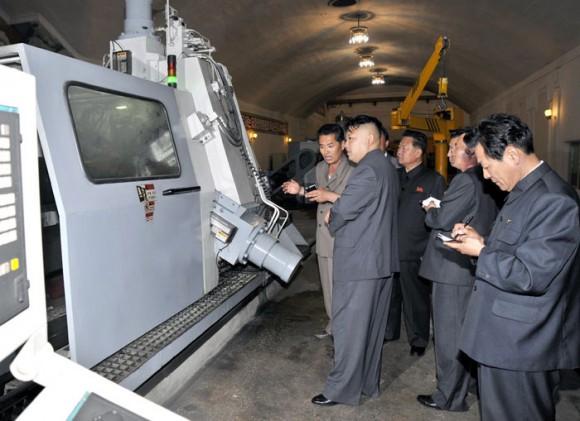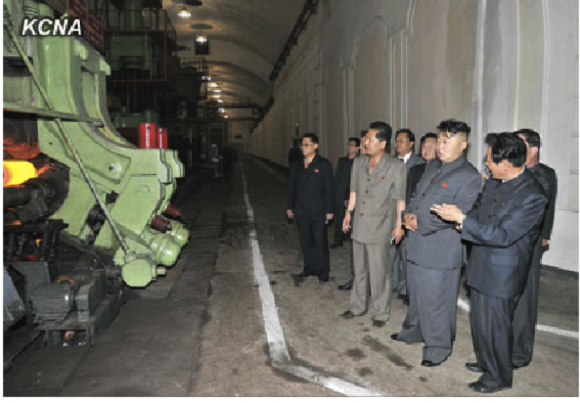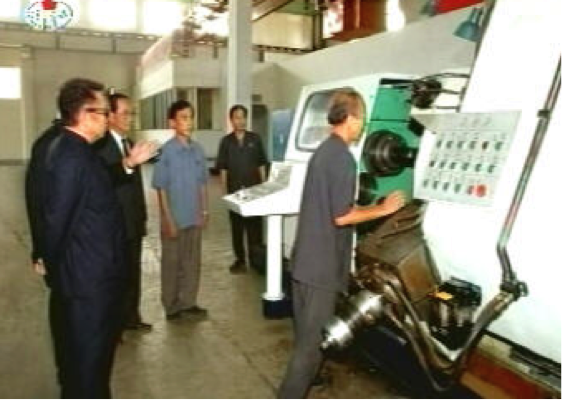Without further ado, a guest post by R. Scott Kemp, assistant professor of nuclear science and engineering at MIT, where he directs the Laboratory for Nuclear Security and Policy.
When it comes to North Korea, there are pretty severe limits on traditional intelligence-gathering. Spy agencies frequently disagree about what’s happening in the country, and rarely can they ever say anything conclusive. North Korea is simply too closed and too disconnected to go snooping around in the usual manner.
But then, sometimes, they just stick what you need in the newspaper.
Kim Jong-un has finally started to visit factories across the country in the tradition of his father and grandfather. In a visit to the Kanggye General Tractor Plant publicized over the weekend, we see him looking at a big machine, but not just any machine. It’s a specialized flow-forming machine of the type used to make centrifuge rotors. Could this actually be a secret centrifuge-manufacturing capability?
Flow-forming machines are pretty rare. There are only a handful of flow-forming companies in the United States, and the coveted machines were among the hard-to-get items traded during the early days of the Khan network. These machines are the only way to manufacture the thin-walled P-2 centrifuge rotor on which the North Korean enrichment program is thought to be built. While flow-forming is used outside of centrifuge manufacturing plants, the applications are limited and only a small handful of applications require the Computer Numerically Controlled (CNC) machine shown above.
(Going by its name, the plant manufactures tractors, and while flow-forming is occasionally used in the automotive industry to make fancy aluminum-alloy rims, it seems unlikely that North Korean farmers are in the habit of outfitting their tractors with 40-inch bling and ranging around Gangnam style.)
And do you see that curved ceiling? Looks like this tractor factory is in an underground tunnel. Hmm…
Elsewhere in the factory, we see this hot piercer mill, a machine that takes raw feedstock and makes the thick-walled seamless tubes that serve as preforms for the flow-forming machines. The dimension of that preform looks pretty close to the dimensions of a P-2 centrifuge rotor.
Much about the facility speaks to its special importance within the industrial hierarchy. This “tractor plant” is located in an isolated area of the country, Jagang Province, about which the outside world seems to know little. Despite their isolation, the local employees have been blessed with recreational facilities far in excess of what the government provides to the average working stiff—like this enormous recreational facility, planted gardens, and a large swimming pool with deck chairs. Life is often best for those that are part of the strategic weapons complex.
To top it off, we find this nice poster on the wall. The resolution is too poor to make out anything with high confidence, but it appears to show objects that look far more like centrifuge rotors than tractors.

I don’t know Korean, but maybe somebody who does can figure out what those posters say. Update. Apparently, the rubric says, “2000t – 400t press process diagram,” indicating that the poster is not centrifuge-related.
The propaganda surrounding this visit also suggests the importance of the facility. According to North Korea-watchers, this appearance is part of the first large wave of publicized visits KJU has made to locations far from the capital city since assuming power—an early and choice destination. The other stops on the tour were machine-tool factories, in particular a precision-machine tool plant that was distinguished by having been awarded the order of Kim Il-song. (See: “Kim Jong Un Provides Field Guidance to Jangjagang Machine Tool Plant,” KCNA, 23 June 2013.) Earlier visits in the current wave included trips to factories with high-precision CNC machines also in what appear to be underground tunnels; these are candidates for making the smaller components of the rotor.
According to North Korea-watchers, previous Kim Jong-un visits outside of Pyongyang as Supreme Commander were almost exclusively to military bases. The present campaign of publicized leadership site visits appears designed to underscore North Korea’s recently adopted “new line” of ideology, in which the economy will be improved at the same time that nuclear weapons are developed. In early April, North Korea announced that it is “readjusting and restarting” its nuclear facilities at Yongbyon, including a gas centifuge enrichment plant, on these grounds.
This is not the first flow-forming machine to be seen in North Korea. Television coverage of a September 2006 leadership visit showed the now-deceased Kim Jong-il inspecting a more primitive flow-forming machine at the Kusong Machine Tool factory, which manufactures machine tools.
That machine looked more like an early prototype; it appears to lack fancy CNC controls. Later, in 2011, five North Korean researchers were awarded a patent for a CNC Control System for an unspecified metalworking machine. The patent award (Ri Yong-chol, Kim Myong-chol, Kim Chi-yong, Kim Kwang-su, and Ri Chol-ung, “CNC Control System of Metal-Working Machine,” Palmyong Kangbo [Pyongyang], 5 October 2011) is short and vague in its description, but it contains keywords that suggest it is for a flow-forming machine.
The latest flow-forming machine at the “tractor factory” appears to be state-of-the-art. When combined with photos showing raw steel billets and the piercer mills, it appears to be part of an assembly-line fabrication process for making thin-walled components. And all of it appears to have been located safely underground. If this facility is making centrifuge rotors, then it appears to be starting from raw feedstock, which incidentally connects nicely with another technical analyses, yet to be published, suggesting that the DPRK is capable of making its own maraging steel from indigenous resources. (Sorry, you’ll have to wait for that one!)
Even if this “tractor factory” is not where P-2 rotors are fabricated, it would still be remarkable for showing that North Korea possesses many of the key technologies needed. Combined with the absence of reports of rotor-related procurements since about 2002 and the full-scale program shown to Sig Hecker in 2010, it appears that North Korea is, at a minimum, well on its way to freeing the centrifuge program from dependence on foreign supplies and technology. Indeed, in the last ten years we have seen almost no reports of centrifuge-related procurements at all, just a few machine tools with possible application in the program and the purchase of UF6-compatible oil.
The traditional modes of watching and intercepting foreign procurements, refined in the era of A.Q. Khan, seem to be inadequate when it comes to North Korea. Yet the DPRK has a record of facilitating the nuclear-weapon programs of other countries and makes a business of selling advanced military technologies around the world. For these reasons, North Korea is arguably the most serious proliferation threat today. The apparent intelligence gap about what’s going on with the North Korean centrifuge program does not bring confidence that we will know what is coming down the pike, or how to respond. Yet it is amazing what can be done with open-source information and the dying art of propaganda analysis. If we want to get North Korea right, it might be prudent to shore up the area of open-source analysis, even if it’s not nearly as sexy as traditional intelligence work.




It appears to be located in a tunnel, no?
Nicely done. The rollerblades upstairs may be new, but some things never change (North Korea, arms production, and tunnels…).
A point and 2 questions: Another nail in the coffin of the notion they’re primitive screw-heads. So what does the presence of these sophisticated CNC Tools say about the results of sanctions and export controls? And, how do they deal with humidity in the tunnels? We found out after the end of the Cold War that the Balkan countries, with roughly similar climate and geology had severe problems with humidity and mold in their underground facilities. Very different from desert environments.
Another thing clear from the photos: KJU and his entourage either have a pronounced preference for extremely long pants, or have shot/jailed all of the DPRK’s tailors.
I’m digging the funky duds.
Truly, Kim Jong-un IS… the Lord of the Pants.
“For these reasons, North Korea is arguably the most serious proliferation threat today.”
To make that argument, you need to dismiss the mainstream proliferators, including the US. And you need to dismiss Israel, which apparently has technology far in advance of the DPRK.
As long as we say “Do as I say, not as I do”, our ability to convince others that we really, really mean it when we say we’re concerned about another nation’s WMD development will be greatly diminished.
The most serious threat to nuclear proliferation may well be the DPRK, but the cavalier insincerity of the US, Russia and other nuclear club charter members is a close second.
Not to mention the politicization of institutions like the iaea
—Several years ago, when I was interested in the decades long attempt to enforce anti-drug laws, I read that the “new” drug “Ecstacy” was dveloped in 1912 by the giant pharmacuetical company Merck.
—It bothers me a lot that each innovation in civilian technology seems to provide a short cut for military uses, including CNC machines.
—what words do I use to describe giant multinational corporations endless pushing new ways to make weapons into the market, including nuclear ones.
If you search Wiki for “Shear Forming” you’ll get an article that explains the flow forming process. There is also a link at the bottom of the wiki page to a manufacturer’s page that explains the process fairly well.
Basically, they’re taking the tube from the press and putting it a mandrel then using a roller under pressure to lengthen and shape the tube into a long, thin walled shape. The process looks something like a metal lathe except instead of cutting away metal you’re squeezing it to a final dimension. The squeezing process heats the metal and also improves it’s strength, which is critical in high speed rotors.
No mention of the other obvious application of flow forming equipment?
Rocket motors.
There is well established DPRK interest and expertise in making rocket motors.
Looking at the size of the billets coming through the piercing mill, I would guess those are too heavy for aerospace applications. It seems like rocket motor parts would be smaller and lighter, especially since they only have to function once.
We’re also making some assumptions here that all the machines shown in the pictures are part of the same production line and all build one final product.
Finally, the intelligence take-away from this is that it looks like North Korea is building their centrifuges domestically rather than importing them as completed units. As Professor Kemp said, this had been inferred from the lack of data on intercepted parts or finished machines, but a lack of data is a shaky foundation to build a conclusion on.
There still had to be a factory somewhere that looked pretty much like this with tools similar to these that made the rotors and now we seem to have (possibly) narrowed it down from “somewhere” to “Jagang Province, North Korea”.
Skeptical. The third photograph shows sawn 300mm billets about 250kg each, and what is coming out of the mill appears to be even bigger than that, look at the thickness. They could flow form that particular tube down inefficiently but my suspicion is this is for heavy machinery – cylinders of fabricated large engine blocks for example.
The photos appear to show several presses in a row, perhaps the piercing press shown is only the first stage and each billet is pressed into a long tube which is cut into smaller tubes which become the actual rotors. Anyone know what a P-2 rotor actually weighs when finished?
After watching a video on how stainless seamless tube is made (How did we live before You tube?) I suspect this is the case. In the video the process starts with a 2-3 meter long cylinder of metal and the finished product is a 10-20 meter piece of seamless pipe. I think there are limits to how thin of a wall you can make in the initial piercing press, and so it would make sense to then stretch the pipe and thin the walls before feeding it to the flow former.
We’re assuming that the square billets seen in the last picture are indeed the raw materials for making rotors. If they are, it’s surprising that they wouldn’t come from the mill in a cylindrical form. One would think that with a project of this strategic importance to the state they could get billets in any shape they ask for, but perhaps the steel mill simply isn’t equipped to make round things.
This may also to some extent answer the question about moisture in the tunnels. If they’re working with white-hot steel which has to be heat treated to over 1500 degrees F in an underground space then they must have some pretty impressive HVAC equipment to keep from roasting the workers!
The key point is the one at the end: this shows that the North Koreans have some key capabilities applicable to centrifuge manufacturing. Whether or not that’s happening at this particular facility.
The more exact location of the complex is shown here: http://nkleadershipwatch.wordpress.com/2013/06/23/kim-jong-un-visits-kanggye-tractor-plant/
One has to wonder who the intended audience for this article was.
Obviously it was intended for internal consumption (Look how good workers have it), but either the censors were totally incompetent, or else someone in North Korea was sending an intentional message to the western intelligence community.
Occam’s razor and past history would lend credence to the former option, but the conspiricist in me favors the latter one.
Agreed. Time and again I’d like to convince myself that North Korean release of information is accidental, but I can never quite do it.
I agree with most of Chtippo’s observations. However, I have some remarks. First of all, the feedstock for this operation is plain to see in picture 3: the metal cubes with 30 by 30 by 30 footprint. That would translate into 150 to 180 kg of high quality steel. One rotor, at dimensions 2 h high, 20 cm diameter, wall thickness 1 mm would weigh about 1 to 2 kg. this translates, with losses included, into 100 rotors per cube. I can count 5 by 5 by 8 cubes at least, minimum 200 cubes. Taken together, 20,000 rotors worth of raw material. Where did Iran get their rotors from? The entire setup of presses and flow handling equpment, housed in underground tunnels, is an extremely high value asset.
Where are the tractors?
What? No binoculars.
Is there any difference in maraging steel used in a centrifuge and the maraging steel used in the anti tank rounds that NK used to make ?
There are several industrial flow forming applications. One of them is manufacturing of rims for wheels, which would make perhaps sense in case of a tractor factory. You can find such a demo in youtube: http://www.youtube.com/watch?v=-kyU-SxePIY.